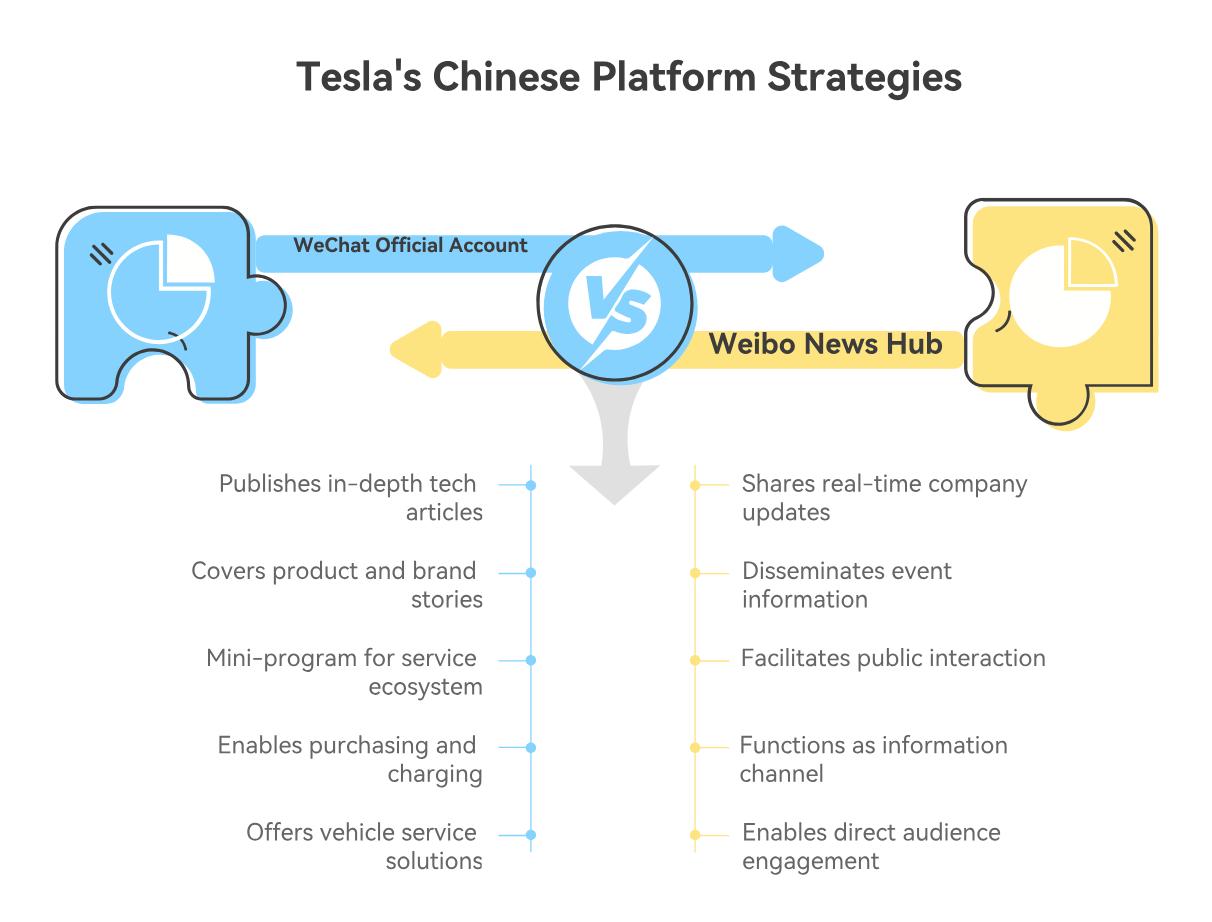Tesla’s Digital Dominance in China: A Masterclass in Localized Marketing
- On August 7, 2025
- brand marketing, tesla marketing
Tesla’s strategy in China is a prime example of successful digital marketing and brand building.
Strategy: Deep Integration, Not Mere Translation
Tesla’s core digital marketing strategy in China is to deeply integrate its brand DNA with local culture and platforms, rather than simply translating its Western marketing materials.
1, Platform Localization: Tesla has a presence on all major Chinese social media and content platforms, including WeChat, Weibo, Douyin (TikTok), Xiaohongshu (Little Red Book), and Bilibili (B-site). Each platform has a specific role:
- On WeChat, Tesla uses its official account to publish in-depth articles on technology, products, and brand stories. Its mini-program creates a closed-loop service ecosystem for purchasing, charging, and vehicle services.
- Weibo functions as a news hub for real-time company updates and event information, facilitating direct interaction with the public.
- Douyin and Xiaohongshu are crucial for content localization and reaching a younger demographic. The brand leverages popular memes, trends, and challenges to make its content more entertaining and shareable.
- Tesla also effectively capitalizes on CEO Elon Musk’s personal brand in China, where he is portrayed as a “tech visionary,” with his statements and activities frequently becoming a focal point for brand promotion.

2, Content Localization: Tesla’s content team has a keen understanding of local user preferences and viral trends. They don’t just produce standard promotional videos; they create short-form videos and graphics that align with Chinese internet culture.
3, Community Localization: Tesla has built a powerful car owner community in China, which is rare for a Western brand. Through online WeChat groups, in-app communities, and offline owner events, Tesla has transformed its customers into loyal brand advocates. These owners spontaneously share their experiences and organize events, creating a strong word-of-mouth effect.
Content: From “Hardcore Tech” to “Lifestyle”
Tesla’s marketing content in China has successfully shifted from focusing solely on “hardcore technology” to a more diversified “lifestyle” narrative.
1, Technical Content: While technology is at the core, it’s presented in a more accessible way. They use simple graphics and videos to explain complex concepts like Autopilot or battery technology, making them understandable to the average consumer.
2, Lifestyle Content: This is a highlight of Tesla’s localized content.
- Travel Experiences: A large volume of content comes from owners sharing road trip experiences, showcasing the vehicle’s range and the joy of travel.
- Tech-Driven Living: The brand is positioned as a futuristic, intelligent lifestyle, not just a mode of transportation. Owners share how they use the in-car entertainment system to watch movies, play games, or remotely control their vehicles via the app.
- Social Responsibility: Tesla actively participates in public welfare activities like environmental initiatives and disaster relief efforts, which has garnered widespread social praise in China.
User Feedback: Emotional Resonance and Identity
The key to Tesla’s success in China lies in its ability to build a strong emotional connection and a sense of identity with its users.

- Extremely High Brand Loyalty: Tesla owners often become more than just customers; they are brand “fans.” They will spontaneously defend the brand’s image and counter negative narratives. This level of loyalty is something many traditional brands struggle to achieve.
- Powerful Word-of-Mouth Marketing: Thanks to its robust owner community, Tesla’s word-of-mouth spread is incredibly effective. Potential customers often learn about the product from genuine, peer-to-peer recommendations, which are more convincing than official advertisements.
- Handling of Negative Feedback: While not without its challenges, such as the “brake issue” incident, Tesla’s response has also demonstrated its localized approach. It engaged with the public through official statements and social media interactions, and while the process was not flawless, its swift and direct communication style stood in stark contrast to traditional automakers.
In summary, Tesla’s successful digital marketing in China is the result of its deep localization strategy, diversified content creation, and effective community management. It serves as a powerful case study for how a Western brand can truly understand and integrate into the Chinese market to achieve remarkable commercial success.

 Unlock 2026's China Digital Marketing Mastery!
Unlock 2026's China Digital Marketing Mastery!